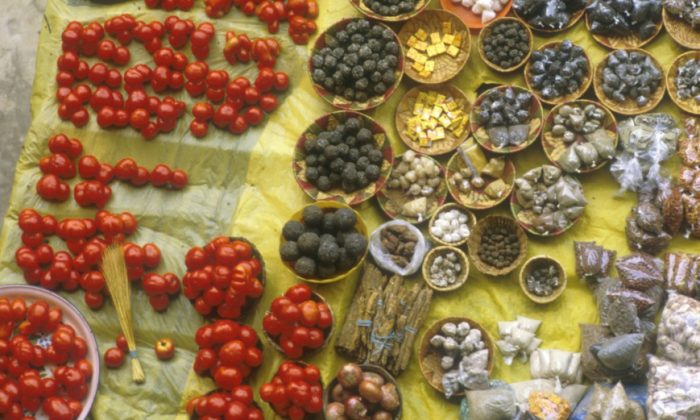AFF Concept note-CoP on NTFPs value chains
- This topic has 21 replies, 8 voices, and was last updated 3 years, 5 months ago by
 Ojo Adedeji Robert.
Ojo Adedeji Robert.
-
AuthorPosts
-
-
November 18, 2021 at 6:55 am #349
 Daphine GitongaKeymaster
Daphine GitongaKeymasterGood morning everyone.
Welcome to today’s e-discussion. The moderator for today is Adedeji Robert.
To participate, type in the chat box below and click submit.
-
November 18, 2021 at 8:19 am #350
 Ojo Adedeji RobertModerator
Ojo Adedeji RobertModeratorGood Morning Everyone
You are all welcome to today’s Community of Practice on NTFPs Value chain -
November 18, 2021 at 8:28 am #351
 Ojo Adedeji RobertModerator
Ojo Adedeji RobertModeratorToday, we shall be continuing with our discussion on
Examples of NTFPs that are of nutritional, medicinal and cosmetic significance on the African continent (incl. fruits and oils, etc.) – examples of value chains – opportunities for development and challenges
Lets set the ball rolling
-
November 18, 2021 at 8:33 am #352
Marie Louise Avana
ModeratorDear colleagues,
welcome to the web platform of the CoP on NTFPs. We are looking forward to hear from you on the NTFP of nutritional, medicinal and cosmetic significance in your national context. what are they? what are the associated opportunities? challenges for the development of their value chains? policies and institutions supporting their development? contribution to national economy and household livelihood? gender consideration in their management? -
November 18, 2021 at 8:37 am #353
 Ojo Adedeji RobertModerator
Ojo Adedeji RobertModerator@Marie-Louise. Thank you
-
This reply was modified 3 years, 5 months ago by
 Ojo Adedeji Robert.
Ojo Adedeji Robert.
-
This reply was modified 3 years, 5 months ago by
-
November 18, 2021 at 9:15 am #355
Claude
ParticipantGood morning and thank you every one for this e-discussion. I am just joining
-
November 18, 2021 at 9:21 am #356
 Ojo Adedeji RobertModerator
Ojo Adedeji RobertModerator@ Claude, You are welcome. Sorry for the glitch
Can you please react to the issue/question raised by Marie?
-
November 18, 2021 at 9:41 am #357
Claude
ParticipantLE MEDICINAL IMPORTANCE OF NTFPs AND THEIR CONTRIBUTION TO THE GDP OF CAMEROON
According to some authors, more than 500 plants are used in Cameroon as medicinal plants. Some are even exported and used in the pharmaceutical industry. For example: pygeum (Prunus africana), yohimbe (Pausinystalia yohimbe), moabi (Baillonella toxisperma) and voacanga (Voacanga africana). But their contribution to the GDP is very low. The contribution of the forest sector in the GDP of Cameroon is about 4% on which NTFPs contribute only 0.55% (CIFOR-MINFOF, 2013). Therefore there is a lot to do to enhance the contribution of the NTFPs in Cameroon.
-
November 18, 2021 at 9:48 am #358
 Ojo Adedeji RobertModerator
Ojo Adedeji RobertModeratorThanks @Claude. Is there any challenges for the development of their value chains? policies and institutions supporting their development? in Cameroon
-
November 18, 2021 at 9:59 am #359
Claude
ParticipantConcerning the institutional challenges, there is a beginning of solution in Cameroon with the “Plan National de Développement des Produits Forestiers Non Ligneux” elaborated Jully 2012. From that Plan, the Minister in charge of forestry took a decsion in 2019 to classify special forest products and NTFPs into 3 categories according to their economic value, the socio cultural importance and ecological durability.
-
November 18, 2021 at 10:04 am #360
Claude
ParticipantYes there are a lot of challenges:
– Technological challenges for the processing or transformation of the products as most of the indigenous exploiting are not aware of their existance . Which explains why Prunus africa is mostly exported (the bark);
– Low implication of business men in the sector due to the lack of material, etc.
-
-
November 18, 2021 at 10:28 am #361
Marie Louise Avana
Moderatorvery good contribution from Cameroon Claude. Yes the challenges for the development are almost the same across the NTFP sector. Poor investment from the private sector, lack of appropriate technology for processing. There is a need for enabling environment that could attract more private sector investment in the subsector.
-
November 19, 2021 at 7:37 am #362
 Ojo Adedeji RobertModerator
Ojo Adedeji RobertModeratorGood Morning Everyone
Welcome to today’s CoP discussion
-
November 19, 2021 at 8:08 am #363
 Ojo Adedeji RobertModerator
Ojo Adedeji RobertModeratorGood morning everyone once again,
yesterday We looked into the NTFP of nutritional, medicinal and cosmetic significance in your national context. what are they? what are the associated opportunities? challenges for the development of their value chains? policies and institutions supporting their development? contribution to national economy and household livelihood? gender consideration in their management?
Today, we are continuing in the same direction, taking into consideration the questions raised yesterday as given above
Lets hear from you
-
November 19, 2021 at 8:24 am #364
Christopher Komakech
ParticipantThe followings are my comments regarding challenges in the development of NTFPs in Africa
1) Failure to recognise NTFPs as a source of livelihood support for majority of rural dwellers and potential to scale up as a formal business that contributes to national economies despite a lot of informal trade going on.
2) We need research to evaluate the value chains and make a proposition to policy makers in monetary terms to see how much is being lost by not formalising the sub-sector
3) There is a lot to be done to educate and sensitized rural communities about the values of the different NTFPs which some are already being marketed intentionally and they are not aware. IPs being generated can make a lot towards improving their livelihood
4) We need policy shifts so that these products become commodities for trade and sources as well as production, processing, packaging etc can be traced. Should be treated just like other agricultural produce
5) We need research and development to boost production both at community and farm levels and that will require shifts in our training in local institutions still stuck in the colonial era structure. Because they were neglected at the time when resources were not dwindling at the current rates due to huge population surge, we need to rethink the way we see things now and going into the future. Rural communities need to be part of the process so that they realised it is being done with them and not for them as is always the case. -
November 19, 2021 at 8:52 am #365
 Ojo Adedeji RobertModerator
Ojo Adedeji RobertModeratorThanks @Komakech. Based on your number 2 point ” We need research to evaluate the value chains and make a proposition to policy makers in monetary terms to see how much is being lost by not formalising the sub-sector”
On research, do you know any organization that may be willing to support and finance such research?
For example, I have a proposal on “Effects of Logging on Quantity and Quality of Non-Timber Forest Products” IFS showed interest in the proposal initially but later dropped it for sponsorship. what I am saying in essence is that there is no much organization to come to the rescue of this goldmine called NTFPs -
November 19, 2021 at 9:09 am #366
 owinojesseParticipant
owinojesseParticipantThere is a host of NTFPS in Kenya from Turkana indigenous community that are not in literature, challenge is to get industry to accept to do propagation as well as extractive chemistry to identify active ingredients and also accredit the indigenous knowledge that has led to the identification of those plants
-
November 19, 2021 at 9:24 am #367
 Ojo Adedeji RobertModerator
Ojo Adedeji RobertModerator@Owinjesse, what is the willingness of research institute on the propagation of the species in Kenya.
Just like in Nigeria, Forestry Research Institute of Nigeria is not leaving any stone unturn on some of this species such Garcinia kola, Vitellaria paradoxa, Chrysophyllum albidum, Irvingia wombolu and many more-
November 19, 2021 at 9:44 am #368
 owinojesseParticipant
owinojesseParticipantThe willingness on propagation especially for ASAls requires robust buy in from communities as land is communal owned thus, the successes have been on research established woodlots, with high opportunity for county governments to propagate larger areas with the technical guideline from research institute.
-
-
November 19, 2021 at 9:53 am #369
BlackCamel Energy Ltd
ParticipantAll protocols duly observed.
I have been reading all the interesting and educative comments above and really appreciate everyone’s contributions especially where Christopher highlighted stringent points.
Now from the business point of view, why ntfp rarely contribute hugely to country’s gdp is because of the market strength.
Most African nftp exporters hardly follow due diligence in harvesting which thereby push them to non-premium markets.
Premium markets wants more information especially on TRACEABILITY.
I think more focus should be on training and sentization of locals on how to observe due diligence from production till harvest. This will attract more premium buyers and as well boost production.
The FACT is that when there are premium prices for ntfp, more people will get involve and there will be more inflows.
Most African nftp producers especially in West Africa lacks that little aspect and therby make them prone to less attractive markets.
If there can be help in training more locals in value chain. More people will be interested and this will help the economy.
Lastly, I am sorry if there are typo errors, I am commenting from my mobile phone and also multitasking☺️
Thanks to everyone.
Joseph
BlackCamel Energy Ltd -
November 19, 2021 at 9:55 am #370
abbeylee (Ologun B. Freeman)
ParticipantIn addition,forest resources users particularly those involved in logging activities should be well educated on the importance of NTFPs and the need for them to be protected during exploitation/harvesting of timbers. They should realise that a forest is an ecosystem with a lot of inter-relationships within the system. In Nigeria the experience has been that the loggers most of the times look at the forest from the perspective of timber and that if other resources are there they are of no importance/significance or at best of little importance. This mentality should change.
-
November 19, 2021 at 8:17 pm #374
BlackCamel Energy Ltd
Participant@Abbeylee Yes, you made a very good point in regards to loggers BUT it all still boils down to the fact that NTFP are being considered lesser due to lack of knowledge from most forest stakeholders especially in the timber sector.
However, the Nigerian government through the Federal Department of Forestry under the directorship of Mr. Razaq has taken the bull by the horn and the department are working with relevant stakeholders in developing a national timber legality standard that will managed timber and protect NTFP.
Few stakeholders who also understand SFM and the value of NTFP are doing enough to sensitized others.
I really wish that what is being discussed here won’t die here. In a place where people don’t know the value of gold, they can easily turn it to stone to chase squirrels. Blames might not really go to them because they lack knowledge. It is our collective duties to make them know and realize how precious NTFP are.
In the timber circle it will also please you to know that timber are also been hugely exploited by the Asians who care less of sustainable forest management in West Africa.
Not to digress but we should as well look beyond this online meetings and see if we can translate everything to our people especially the local in a face to face training.
Thank you all.
-
-
November 19, 2021 at 10:05 am #371
 Ojo Adedeji RobertModerator
Ojo Adedeji RobertModerator@Rakunmi and @Ologu Freeman
You have all spoken well
The let comments keep coming in. This CoP discussions will definitely have positive impacts on on NTFPs
-
November 25, 2021 at 8:35 am #378
Dan01
ParticipantEvery fruits and oils that are nutritional are medicinal likewise if its medicinal must be nutritional. The opportunity and value chains this products added to the living standard and livelihood of especially the rural dwellers cannot be overemphasised in contributing to economic development, family sustainability as regards food and supplement, health and security issues. Meanwhile, the major challenge which faces this sector is mode and methods of processing which has negative impact on the even local and international trading of this sector
-
November 25, 2021 at 8:46 am #379
 Ojo Adedeji RobertModerator
Ojo Adedeji RobertModeratorGood day everyone. Our discussion today should be under week 2.
Kindly click on week 2 and make your comments
Thanks
-
November 25, 2021 at 8:48 am #380
 Ojo Adedeji RobertModerator
Ojo Adedeji RobertModerator@Dan01
can you please make this comment under week 2 so that we can elaborate more on it
-
-
AuthorPosts
- You must be logged in to reply to this topic.

